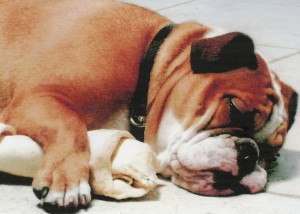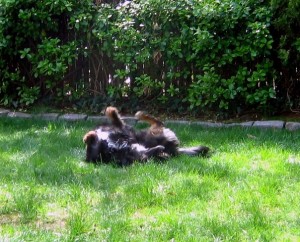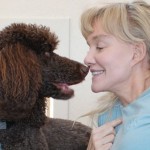 Resource guarding, biting, and on-leash reactivity to other dogs are typical offenses that pepper the rap-sheet of so-called “red-zone” dogs, dogs that allegedly are attempting to dominate people or other dogs with displays of aggression.
Resource guarding, biting, and on-leash reactivity to other dogs are typical offenses that pepper the rap-sheet of so-called “red-zone” dogs, dogs that allegedly are attempting to dominate people or other dogs with displays of aggression.
Welcome to the fourth post in our six-part series: Difficult, Aggressive Dogs Need Strong Training. (Really?)
John Visconti continues his story about rehabilitating and training Pepper, a dog with all of the above afflictions, and more.
All too often the offenses of resource guarding, biting, and dog-dog aggression are viewed through the lens of “dominance.” This perspective typically leads dog handlers to take an adversarial stance toward the dog they are ostensibly trying to help. A contest of wills, masquerading as rehabilitation and training, ensues. Just take a spin through cyberspace and you’ll find videos of a celebrity dog handler trying to “shock” a dog out of her food guarding, and claiming to cure another dog’s reactivity to dogs by “strangling” him until he collapses. (If you’re interested in the videos, click here and here.)
Unfortunately, this sort of aggressive dog handling (I refuse to call it either rehabilitation or training.) that relies on aversive punishments is practiced by many handlers. Most of us can find them in our very own communities.
Thankfully, there is another way. In fact, within the domain of positive dog rehabilitation and training, there are many ways to treat resource guarding, biting when touched, and dog-dog aggression.
Join John as he uses smarts, compassion, and science-based methods to help Pepper feel more comfortable in her own skin, and learn skills for navigating her world.
Part 4: RESOURCE GUARDING? BITING THE HAND THAT TOUCHES YOU? ON-LEASH REACTIVITY TO DOGS? NO SWEAT.
Surprisingly, especially since Pepper had bitten me at the shelter over a pigs ear, and given the fact that I’ve always assumed guarding to be a fixed action pattern, her guarding issues vanished within a week or so.
She wasn’t a food bowl or location guarder. She was an object guarder. So we worked on trades of low value items for higher value ones. Once confident, I began to ask other people to do so as well.
Today, she’ll gladly give up even the most treasured objects to anyone.
Body Touch Sensitivity
For Pepper body touch reactivity was so severe that I couldn’t touch her hindquarters and neither could her veterinarians. The shelter veterinarian as well as my veterinarian both insisted that she wear a muzzle for examinations. In fact, her initial shelter examination report states “Dog would not allow examination of hind quarters.”
Desensitizing Pepper to touch was the plan. I would touch, reward. Touch closer to the charged area, reward again. I made sure not to proceed in a direct line to the trigger zone but instead, I’d move an inch closer, reward, then two inches back, reward, then two inches forward, reward.
This was the “cha cha” method of desensitizing. She was too smart not to know what I was up to if I approached the “danger” zone in a direct line pattern. On the rare occasions where she swung her head toward my hand, I reflexively responded with a stern “Cut the crap.”
Muzzle wearing at the vet’s is now officially a thing of the past. During a visit to the veterinarian a year later, he drew blood twice, and did a full body exam including emptying anal glands.
My veterinarian marveled at how much she had changed and as a result has referred training customers to me. Imagine that. Pepper is so well behaved that she gets me referrals.
On-leash Reactivity to Other Dogs
Pepper’s on-leash reactivity toward other dogs was solved with basic, foundational skills. As I mentioned earlier, her reactivity was very strong. Soon after I adopted her, she responded so violently to seeing another dog that was approximately 150 feet away, or more, that the force of her lunge into my leg completely tore the cartilage in my knee, which required surgery.
Before we took to the streets we worked on a “watch” cue. I wanted to have a management tool in place. From “watch” she learned “heads up.” (A great example of her doing this is on my website under “Pepper a Success story” Video #6).
“Head’s up” is nothing more than a moving “watch” cue. While she performed her watch cue perfectly, the problem was, it left us stuck in one spot. So if we encountered another dog while on a walk, as the other owner was saying, “Oh, it’s ok, my dog loves other dogs!” we were a sitting target as they approached. So, “heads up” became our way of high tailing it out of Dodge.
For the last part of the process, we spent many weekends in a local PETCO parking lot. At first, we systematically desensitized from the far end of the parking lot. Simply, the second a dog appeared, she received a food reward.
After a few weeks of this, we moved to an operant mode. If she saw a dog, I immediately cued “watch” and then rewarded. Today, the sight of another dog is a cue for an auto-watch. I no longer need to ask her to watch me.
We have a scorecard on the refrigerator. I keep track of how many dogs we’ve passed on walks without showing reactivity. We are currently at 37 occurrences!
While at the shelter, one of Pepper’s fosters commented “You had better be careful about having people over to your home. Pepper barks wildly and charges. She’s telling you, ‘I don’t want this person in our home and you had better listen to me.’”
Clearly, this was not a plan I was willing to follow.
Part 5 of John’s and Pepper’s story will be posted on Monday, April 11, 2011.
See you then!
——————————————
Previous posts in this series:
Part 1: Difficult, Aggressive Dogs Need “Strong” Training. Really? (John’s story: John Meets Pepper)
Part 3: Difficult, Aggressive Dogs Need “Strong” Training. Really? (John’s story: Positive Does NOT Mean Permissive)
Subsequent posts in this series:
Part 5: Difficult, Aggressive Dogs Need “Strong” Training. Really? (John’s story: People-aggressive dog? Positive Dog Training to the Rescue.)











Followed a link over here from Karen Pryor’s twitter and I’m glad I did! What a wonderful series.
Anyway: I love reading about stories like Pepper’s because it gives me hope for these “difficult” dogs. Our six month GSD became leash-aggressive/stranger aggressive around four months of age despite lots of work to socialize him. We start with a good positive-methods trainer next week, but I really should be playing more “look at this” and working on a “head’s up” type cue with him. The clicker has worked beautifully with him so far for basics like “sit” and “shake”. I might need to break the on-leash stuff down into smaller components. Food for thought.
I’m so glad you are enjoying the series. “Look at this” is a great exercise. I’ve used it with my fearful dog, Sadie. She’ll bark at something that scares her if she becomes fixated on it. So we have a 3 second rule. She can “look at that” for 3 seconds, then I click and she turns to me for her R+. Most of the time now she just glances at what otherwise might have worried her and looks a me. Occasionally we still encounter something that grabs her attention, like yesterday on the trail–she saw a man off-trail walking very slowly in the mist–then it’s back to the 3 second rule. Usually I’m able to catch her–click– before she barks. It’s a process! Good luck!
Mel. Thank you for the kind words.
Just a thought for your GSD. You might want to think in terms of criteria. At first, I’d desensitize with a food reward every time a dog appears, without looking for any specific behavior from your dog. That would be the desensitization part of the program. You can systematically do this from a distance and then begin to close the distance.
You can then move to the more operant approach where you’re looking for specific behaviors before rewarding/reinforcing.
John
Pepper’s story is so inspiring!
Yes, indeed! Thanks.
Thanks. Yep, she has been a life changer for me. I lucked out when I decided to bring her home.
A new command to use “Cut the Crap”, I need to change mine from “Oh stop” , hopefully cut the crap will work better.
Great series, am looking forward to the next posting.
Thanks!
Well, yes…CTC (Cut the Crap) is a foundational part of behavior modification. 😉
I figured, I’m allowed to express myself too. I think it’s healthy (so long as it isn’t abusive).
With regard to object guarding, I wanted to say to her, “You’re kidding, right? I GAVE you the bone. If I wanted it, I wouldn’t have given it to you! OK, so are we over this now?”
That instead morphed into “Cut the crap” 🙂
John
Hello,
I have a 1 year old dog that we rescued from the shelter when he was 7 weeks old. He has always had resource guarding issues and we have been working on these issues with him since he was a couple of months old. We have worked with a trainer extensively and have had him on a learn to earn program. The guarding has has not gotten better. We also just had a baby. When it was just the two of us we felt comfortable dealing with the dog’s issues, negotiating him out of a guarding situation and working around him. But even then he would sometimes aggress at us. Now that we have the baby we are very fearful of what will happen when she begins to crawl, etc. We just don’t trust him and are sadly considering trying to find another home for him. We are deeply saddened and don’t consider ourselves quitters but must put the safety of our daughter first. Any thoughts/advice?
Thank you
First, my apologies for my very tardy reply. I’ve taken some time off from blogging and just now found your request for help. I have forwarded your request to John, the author of the post.